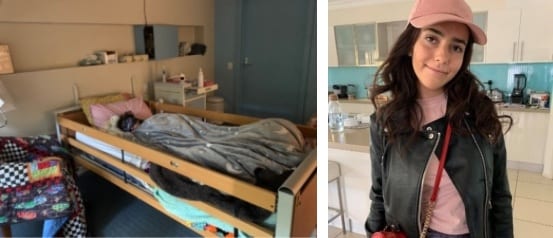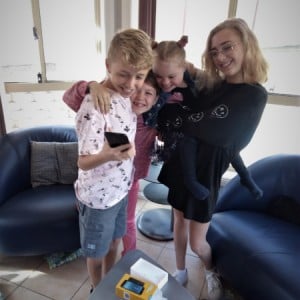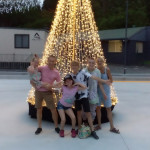A mum talks about how her daughter’s first seizure at 14 changed the whole family’s lives. She had no idea that her child was living with a rare disease.
Angelina wanted to become a makeup artist and business owner; she was in school musicals, acting classes and was a social girl with big dreams for the future. But that changed when, in 2018, Angelina started feeling different.
I didn’t think much of it. When she was exhausted after her day, I let her stay home from school and when her grandfather passed away and she collapsed, we thought it must have been the stress of the situation. But when she began having trouble doing everyday things like setting the table or walking the dog, I made an appointment with a specialist just to be sure. That was when she had her first seizure.
I had never seen a seizure before in my life. I was holding her in my arms, screaming and crying, with no idea what was wrong or if my girl was going to come back to me.
When she went into the hospital, the doctors at first diagnosed her with epilepsy. After nearly a year of no results and escalating seizures though, I knew something wasn’t right.
Getting a diagnosis, what genetic testing showed us.
After a prolonged stay at the hospital, Angelina underwent genetic testing which showed that she had Lafora Disease – a terminal neurological disease with only around 250 cases worldwide. I had never heard of Lafora Disease before – I wasn’t even familiar with what a rare disease was and how many conditions it included. Being so rare, it had been hard to diagnose and even once we had a name, there was limited information and no cure. Angelina is the only registered Lafora disease patient in Australia.
But ever since the diagnosis, I’ve found families like us that have provided us with support, strength and hope. Even though there’s no one like Angelina in Australia, these families still go through shared experiences – the wondering, the isolation, the lack of answers and the constant challenges of a world that doesn’t really understand what rare really means.
Though it’s been hard to access care and treatment, I’m doing all that I can to support Angelina. Part of that is making sure that more people are aware of these rare diseases and how they are diagnosed. I can’t imagine how many other families out there might be in the dark.
Having a rare disease has completely changed Angelina’s life
Though just two years ago, her schoolbooks were full of neat writing, now she is lucky to write a few words or read short sentences. Basic, everyday things, like wearing a shirt, can now be a struggle for her.
With the frontal cortex of her brain affected, Angelina has experienced disinhibition, memory loss and it now takes her longer to process and understand conversation. As Lafora is part of the more than 70 disorders that lead to childhood dementia, we’ve been working with organisations like The Childhood Dementia Initiative to really campaign for research and change.
Angelina is now on several medications to manage her seizures and her behavioural challenges. During some of these periods, Angelina can refuse to eat, get out of bed or undergo her therapy. We are on high alert everyday as Angelina is at high risk of Sudden Unexpected Death in Epilepsy (SUDEP) and it is no telling when her health may decline even further.

But Just Like a Butterfly – Angelina is continuing to bounce back
Angelina has gone through so much and the journey with my brave, beautiful girl has been a difficult one to walk. But I am so proud to be Angelina’s mum. She works so hard and has bounced back from even the darkest days.
Drawing from our love of music, I’ve even written and recorded a song for Angelina – ‘Just Like a Butterfly’ to share with the world her resilience, strength and our hopes for the future. It’s available on Spotify, Apple Music, TikTok and many more digital music platforms.
I hope that more Australians can be made aware of rare diseases and the fact that so many children and so many families live with the unknown. It’s so important that people understand why things like research, funding, access to genomic testing and support is so game-changing for families like mine.
Rare Disease Day is marked on the 28th February every year. This global movement is set to raise awareness for the over 300 million people worldwide living with a rare disease, 2 million of those being Australians and 400,000 of which are children – who need equitable access to diagnosis, treatment, care and social opportunities.
Many Australian families spend years trying to pinpoint the problem – often leaving them feeling isolated from others or in an unknown limbo – with the average diagnostic odyssey lasting approximately 7-years.
Have you or anyone you know had experience with a rare disease. Tell us in the comments below.






















12:24 pm
8:15 pm
10:10 pm
6:28 am
9:41 pm
6:19 am
-

-
-
Ellen replied
- 15 May 2021 , 6:21 am

Reply8:07 pm
4:52 pm
3:44 pm
12:10 pm
1:16 pm
7:40 pm
1:21 am
11:42 pm
9:01 am
12:50 am
7:44 pm
10:02 am
8:50 am
6:59 am
- 1
- 2
- »
Post a commentTo post a review/comment please join us or login so we can allocate your points.